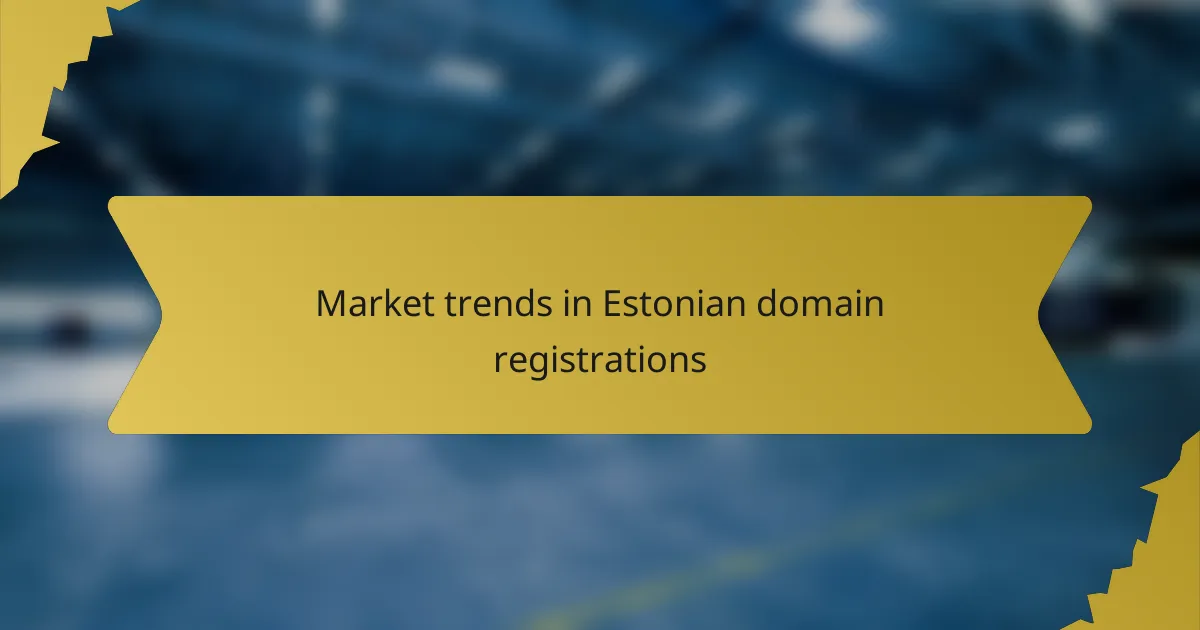Recent trends in Estonian domain registrations highlight a notable surge in .ee domains and an increasing interest in new top-level domains (TLDs), underscoring the importance of online visibility for local businesses. This growth is indicative of Estonia’s robust digital economy and supportive regulatory framework, making it a competitive player in the European and Baltic domain markets. Understanding these trends is essential for businesses and individuals looking to establish a strong online presence in the evolving digital landscape.
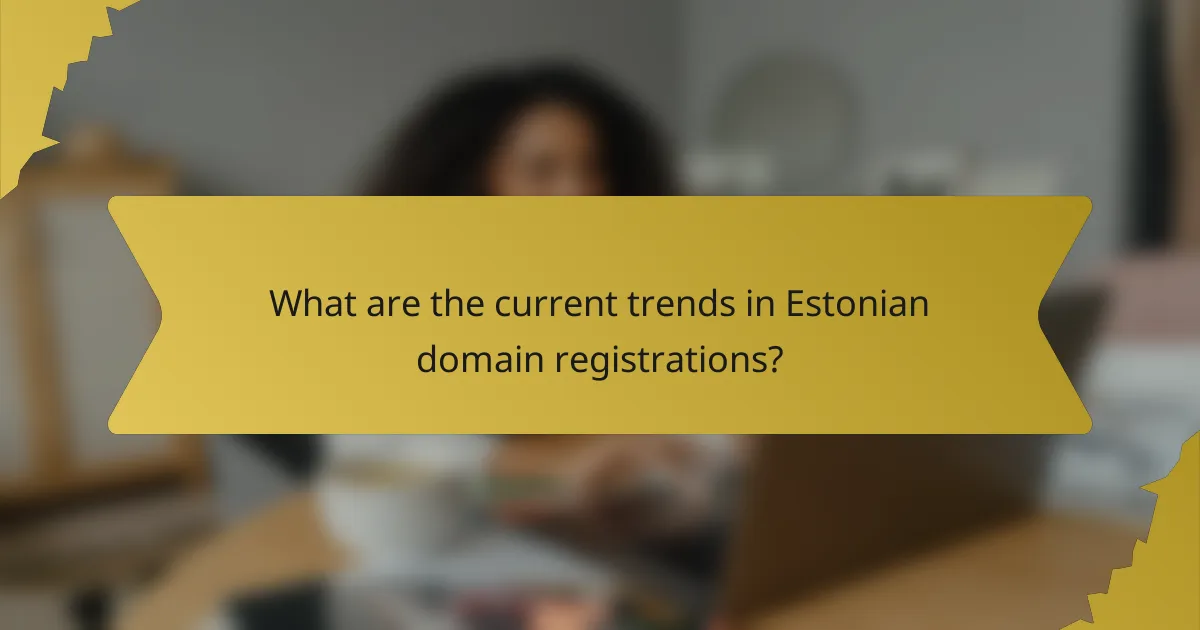
What are the current trends in Estonian domain registrations?
Current trends in Estonian domain registrations indicate a significant increase in .ee domains, a rise in new top-level domains (TLDs), and a growing focus on local businesses. These trends reflect the evolving digital landscape in Estonia, driven by the increasing importance of online presence for companies and individuals.
Increase in .ee registrations
The .ee domain is experiencing a notable surge in registrations, reflecting the growing recognition of its value for local businesses and individuals. This trend is fueled by a desire for national identity and trust among Estonian consumers. As of recent reports, .ee domains account for a substantial portion of all registered domains in Estonia.
Businesses are encouraged to secure .ee domains to enhance their visibility and credibility in the local market. This can be particularly beneficial for startups and small enterprises aiming to establish a strong online presence.
Growth of new TLDs
Alongside the increase in .ee registrations, there is a marked growth in new TLDs, such as .online, .store, and .tech. These domains offer businesses more options to create unique brand identities and cater to specific audiences. The flexibility of new TLDs allows for creative marketing strategies that can differentiate businesses in a competitive landscape.
Estonian entrepreneurs are increasingly adopting these new TLDs to align their domain names with their business models, enhancing their appeal to both local and international customers.
Shift towards local businesses
There is a clear shift towards supporting local businesses in Estonia, which is reflected in domain registration trends. Consumers are increasingly favoring Estonian brands, leading to a rise in registrations by local enterprises. This trend is bolstered by initiatives promoting local products and services, encouraging businesses to establish their online presence.
Local businesses are advised to prioritize .ee domains to strengthen their connection with the community and leverage local SEO advantages.
Rise in e-commerce domains
The e-commerce sector in Estonia is booming, leading to a significant rise in domain registrations related to online retail. Businesses are recognizing the importance of having a dedicated online platform to reach consumers effectively. This trend is particularly pronounced in sectors such as fashion, electronics, and food delivery.
Entrepreneurs looking to enter the e-commerce space should consider securing relevant domain names that reflect their product offerings and resonate with their target audience.
Impact of digital transformation
Digital transformation is reshaping the landscape of domain registrations in Estonia. As more businesses move online, the demand for domains that reflect digital services and products is increasing. Companies are investing in their online presence to stay competitive, leading to a rise in registrations across various sectors.
To capitalize on this trend, businesses should assess their digital strategies and ensure they have appropriate domain names that align with their brand and services, facilitating easier access for consumers in the digital marketplace.
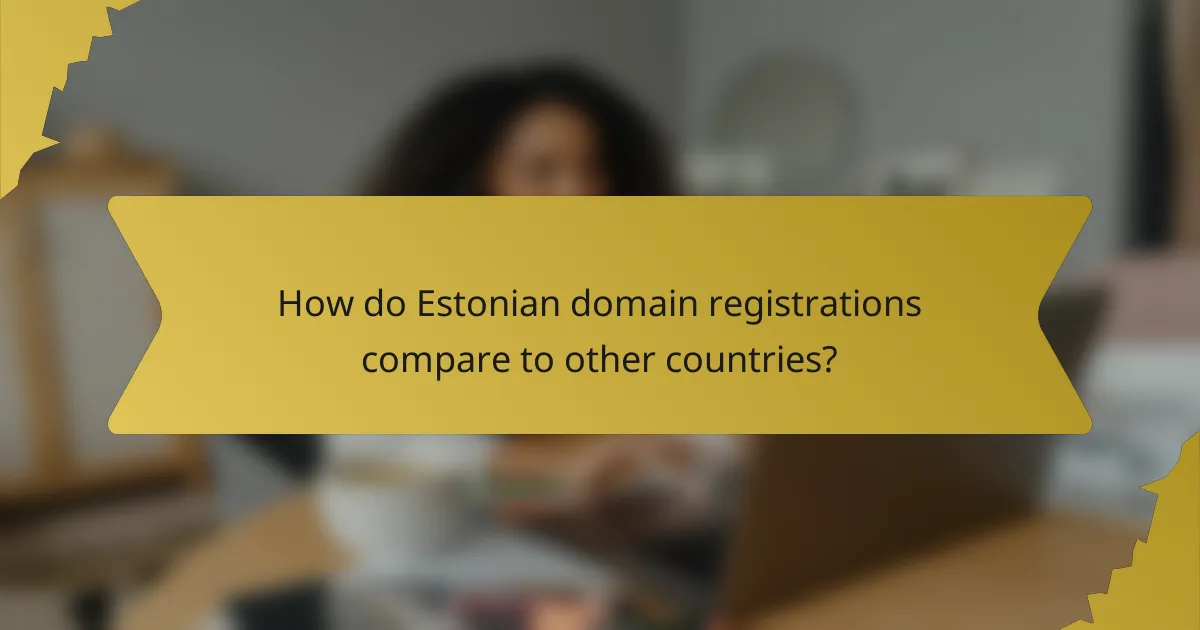
How do Estonian domain registrations compare to other countries?
Estonian domain registrations, particularly the .ee domain, are competitive within Europe and the Baltic region. The growth in registrations reflects a strong digital economy and a favorable regulatory environment, positioning Estonia favorably compared to many other countries.
Comparison with Baltic states
In the Baltic region, Estonia leads in domain registrations, with a significant share of the market compared to Latvia and Lithuania. The .ee domain is preferred for local businesses, while .lv and .lt domains are more common in their respective countries.
Estonia’s proactive approach to digital governance and e-services has fostered a robust online presence, encouraging businesses to register .ee domains. This trend is supported by government initiatives aimed at enhancing digital infrastructure.
Global ranking of .ee domains
The .ee domain ranks well globally, often appearing in the top tier of country-code top-level domains (ccTLDs). Its popularity is attributed to Estonia’s reputation as a tech-savvy nation and the ease of registering domains.
Estonia’s digital identity and e-residency program have further boosted the appeal of .ee domains, attracting international businesses looking to establish a presence in the EU. This has contributed to a steady increase in registrations over recent years.
Trends in EU domain registrations
Across the European Union, domain registrations have seen a consistent upward trend, driven by the growing importance of online presence for businesses. The .ee domain reflects this trend, with a notable increase in registrations from both local and international entities.
Factors such as the rise of e-commerce and digital services have influenced domain choices, with many businesses opting for country-specific domains to enhance their local credibility. As digital transformation continues, the demand for .ee domains is expected to rise, aligning with broader EU trends.
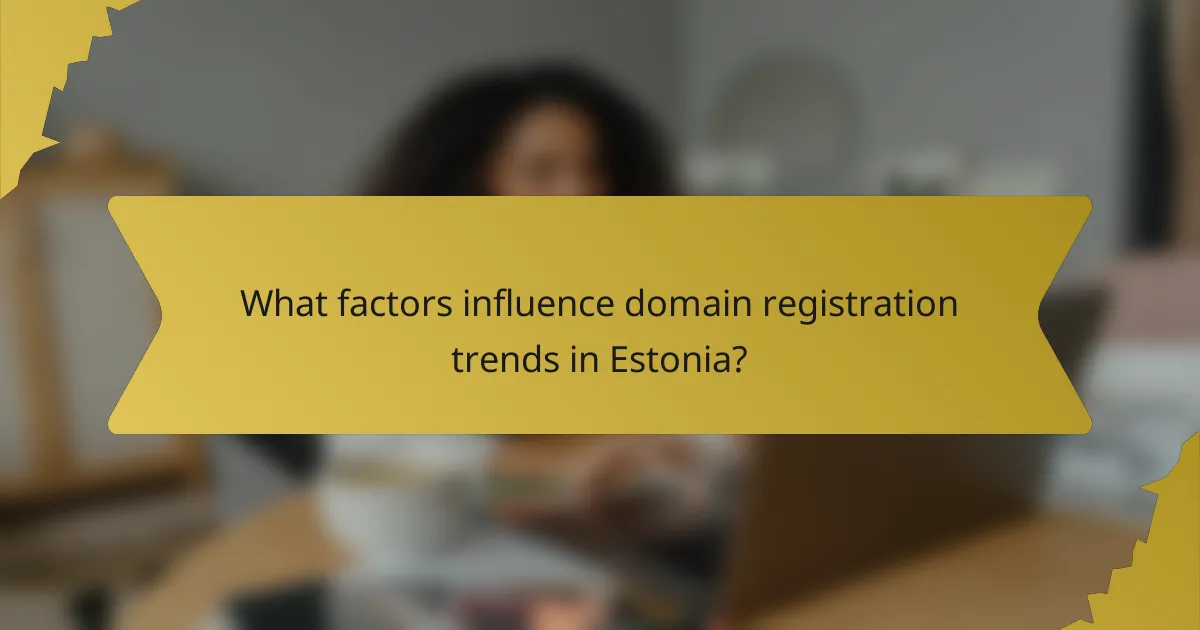
What factors influence domain registration trends in Estonia?
Domain registration trends in Estonia are influenced by various factors including government policies, technological advancements, and the growing market demand for online presence. Understanding these elements can help businesses and individuals navigate the domain registration landscape effectively.
Government policies
The Estonian government plays a significant role in shaping domain registration trends through regulations and initiatives that promote digital innovation. Policies that support e-governance and digital entrepreneurship encourage more individuals and businesses to register domains.
For instance, the introduction of the .ee domain has made it easier for local entities to establish an online identity. Additionally, government-backed programs often provide resources and guidance for startups, further boosting domain registrations.
Technological advancements
Technological advancements have streamlined the domain registration process in Estonia, making it more accessible and efficient. The rise of user-friendly registration platforms allows individuals and businesses to secure domains quickly, often within minutes.
Moreover, innovations in cybersecurity and online payment systems enhance trust in online transactions, encouraging more registrations. As technology evolves, the integration of artificial intelligence and automation in domain management is likely to further influence registration trends.
Market demand for online presence
The increasing demand for an online presence among businesses and individuals in Estonia significantly impacts domain registration trends. As more companies recognize the importance of digital visibility, the number of domain registrations continues to rise.
Small and medium-sized enterprises (SMEs) are particularly active in this space, often seeking unique domain names to differentiate themselves. This trend is supported by a growing digital economy, where having a website is essential for reaching customers and enhancing brand recognition.
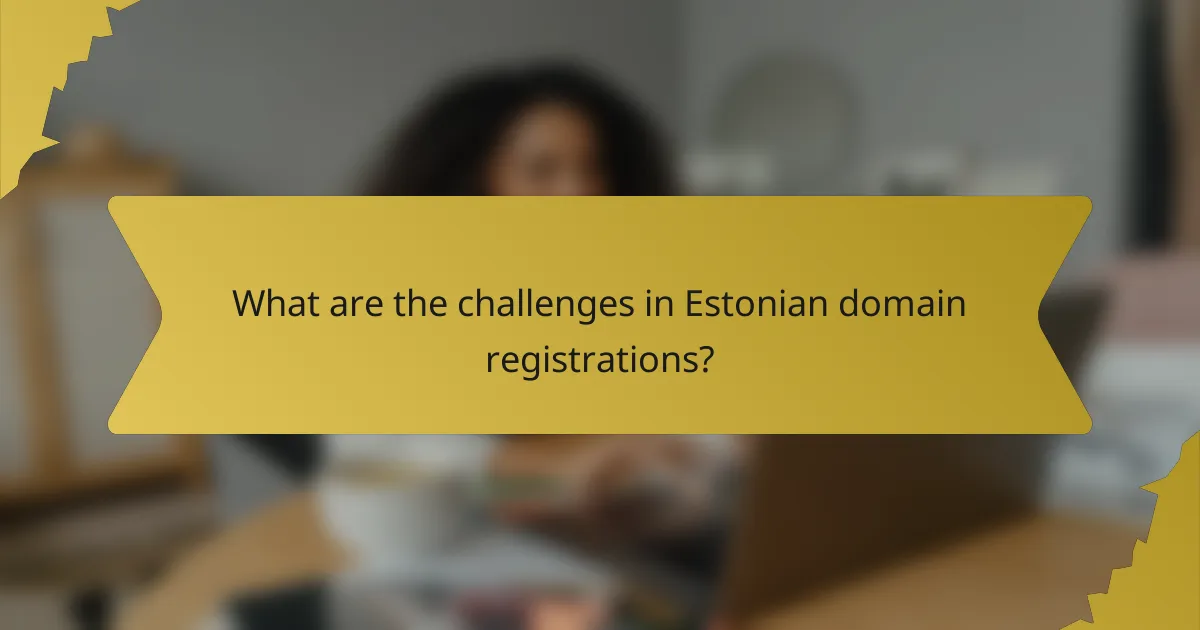
What are the challenges in Estonian domain registrations?
Estonian domain registrations face several challenges, including regulatory hurdles, domain name disputes, and market saturation risks. These factors can complicate the registration process and impact the overall success of a domain in the local market.
Regulatory hurdles
Estonia has specific regulations governing domain registrations that can pose challenges for registrants. For example, applicants must provide valid identification and proof of residency or business registration in Estonia. This requirement can create barriers for foreign entities looking to establish a presence in the Estonian digital landscape.
Additionally, compliance with local laws regarding data protection and privacy is essential. Registrants must ensure that their domain names do not infringe on existing trademarks or violate any legal stipulations, which can complicate the registration process.
Domain name disputes
Domain name disputes are a common challenge in Estonia, often arising from trademark conflicts or similar domain names. When two parties claim rights to the same name, it can lead to lengthy legal battles, which may deter potential registrants from pursuing certain domain names.
To mitigate these disputes, it is advisable for businesses to conduct thorough research before registering a domain. This includes checking existing trademarks and considering alternative names to reduce the risk of conflict.
Market saturation risks
The Estonian domain market is becoming increasingly saturated, with many popular names already taken. This saturation can make it difficult for new businesses to find suitable domain names that align with their brand identity.
To navigate this challenge, consider using creative variations or local language terms that may not be as widely registered. Additionally, opting for less common domain extensions can provide more options while still maintaining relevance to the Estonian market.
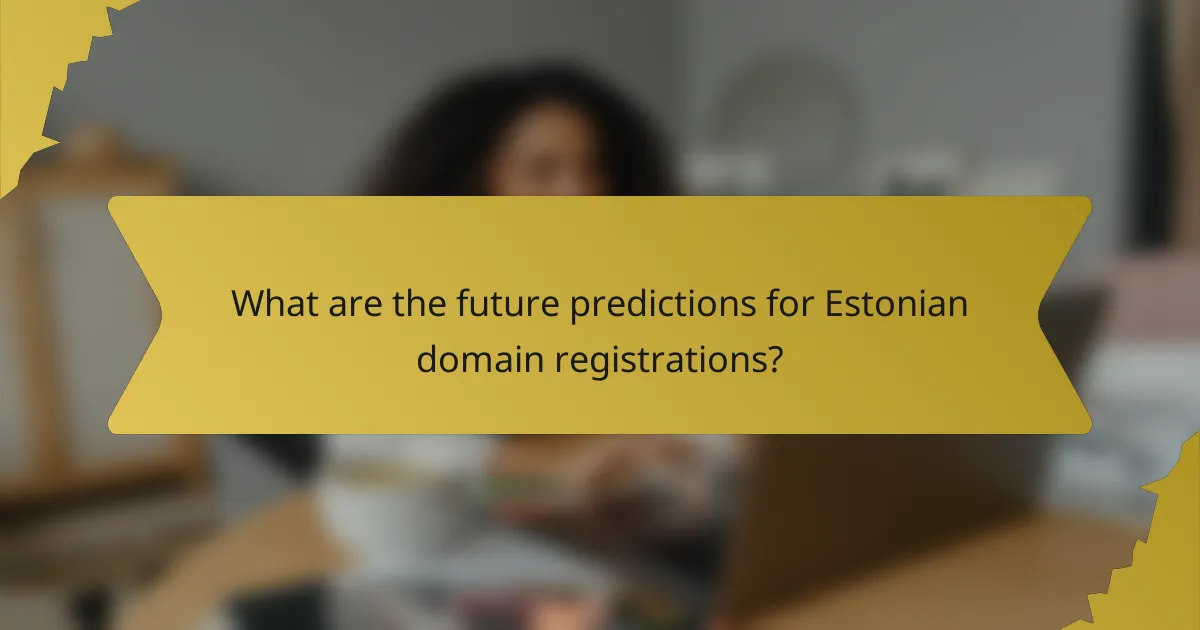
What are the future predictions for Estonian domain registrations?
Future predictions for Estonian domain registrations indicate a steady growth trend, driven by increasing digitalization and a robust startup ecosystem. As more businesses and individuals seek online presence, demand for .ee domains is expected to rise.
Growth in Startup Ecosystem
The Estonian startup scene is thriving, with numerous tech companies emerging each year. This growth contributes to a higher demand for domain registrations as startups establish their online identities. Many entrepreneurs are opting for .ee domains to emphasize their local presence.
Government initiatives supporting innovation and technology further bolster this trend. Programs aimed at fostering entrepreneurship and attracting foreign investment are likely to enhance the visibility of Estonian domains in the global market.
Increased Digitalization
As digital transformation accelerates across various sectors, more businesses are recognizing the importance of having a strong online presence. This shift is expected to drive up the number of domain registrations in Estonia, particularly among traditional industries adapting to digital platforms.
Moreover, the rise of e-commerce and online services is prompting companies to secure their domain names early. This proactive approach helps businesses establish credibility and protect their brand identity in a competitive landscape.
Regulatory Changes and Trends
Estonia’s favorable regulatory environment for online businesses is likely to influence domain registration trends. Simplified registration processes and transparent policies encourage more individuals and companies to register .ee domains.
Additionally, as cybersecurity concerns grow, businesses may prioritize securing their domains to protect against potential threats. This focus on security can lead to an increase in registrations for domains that offer enhanced protection features.
